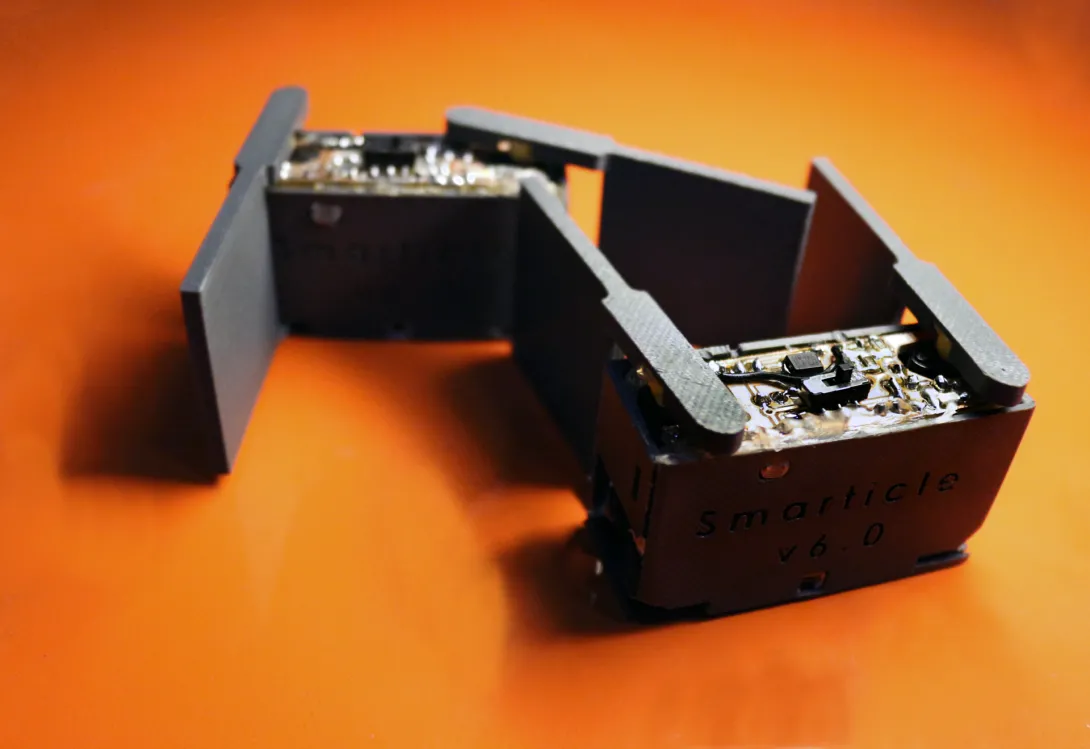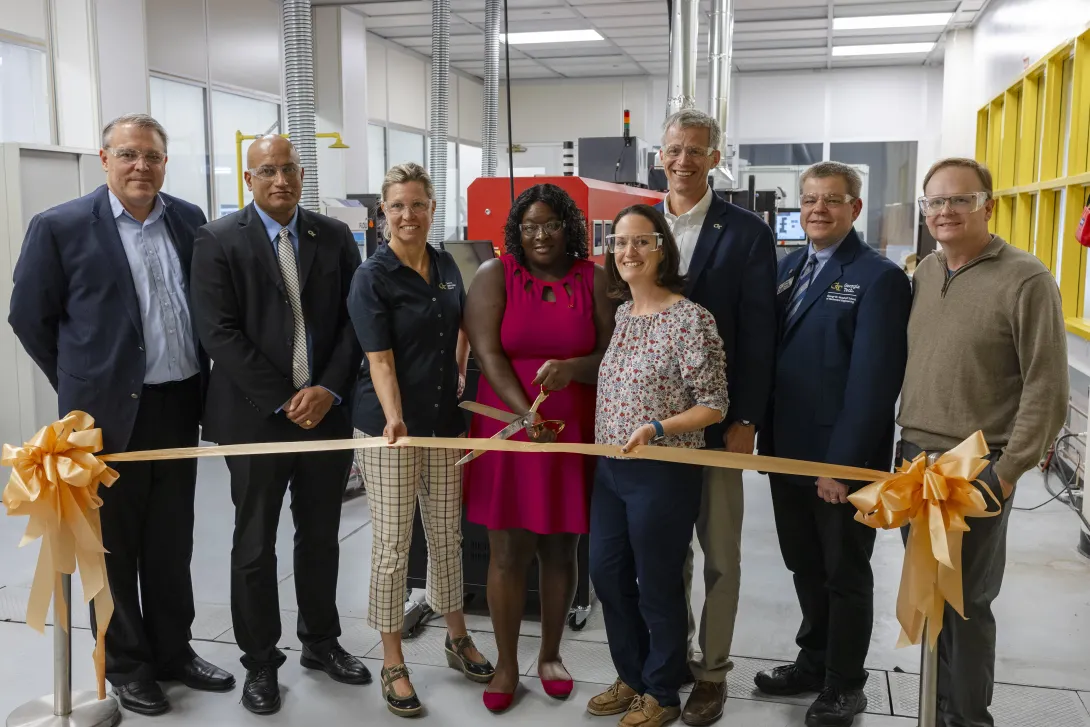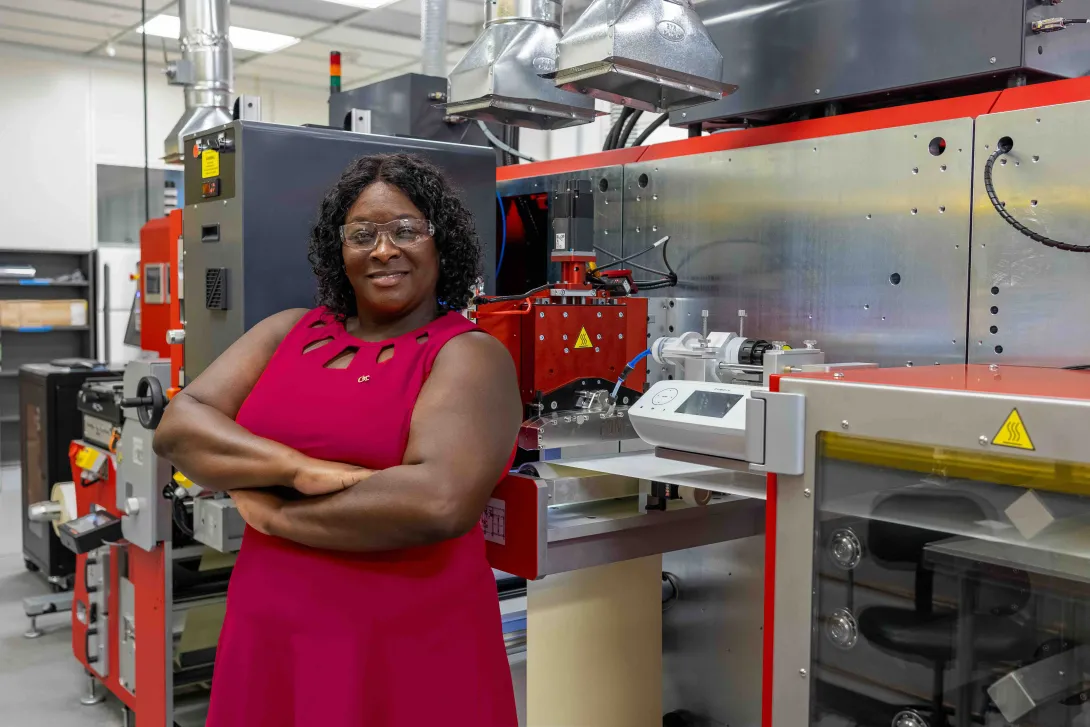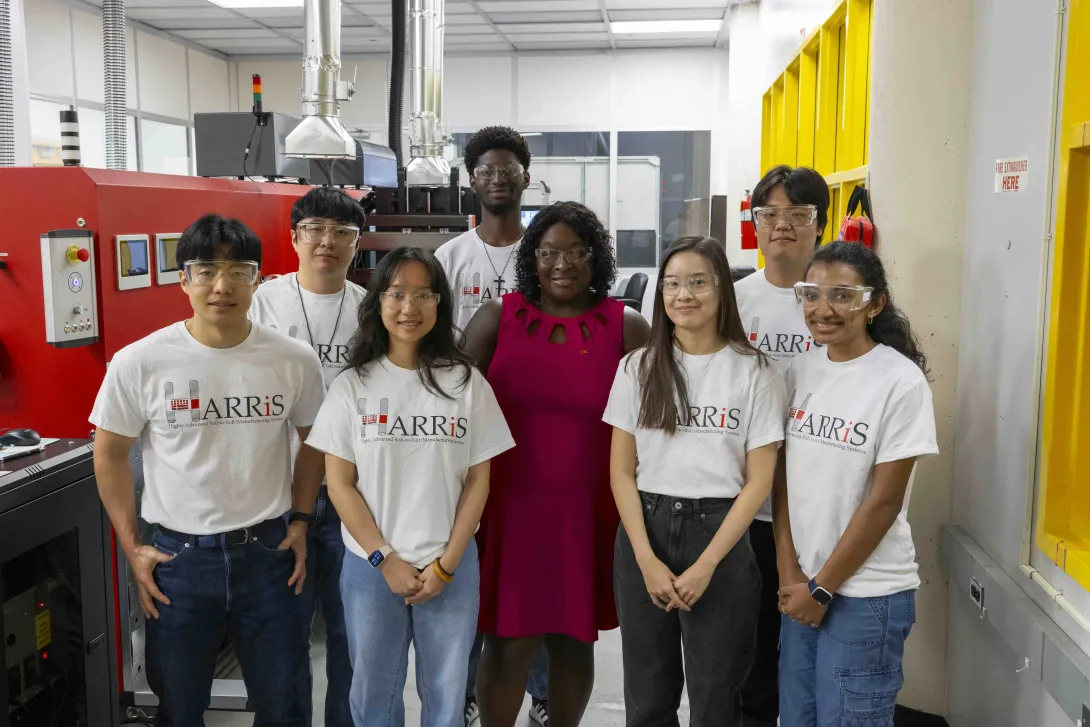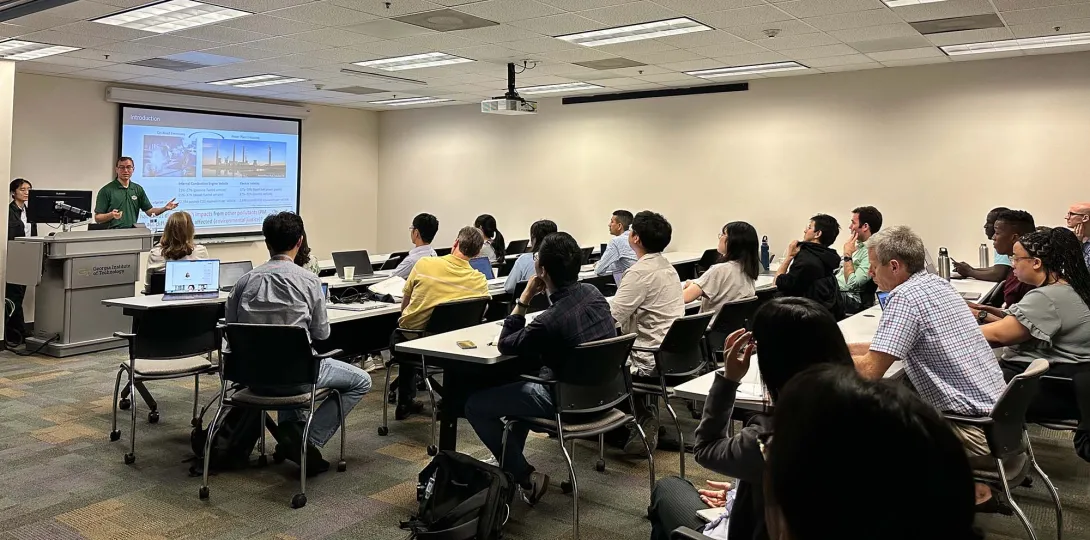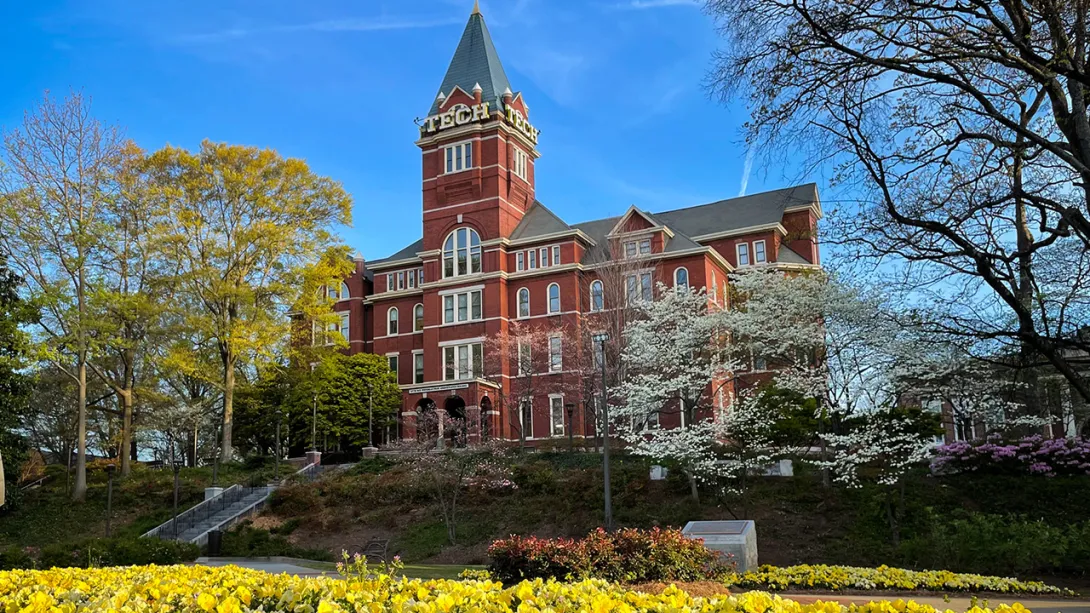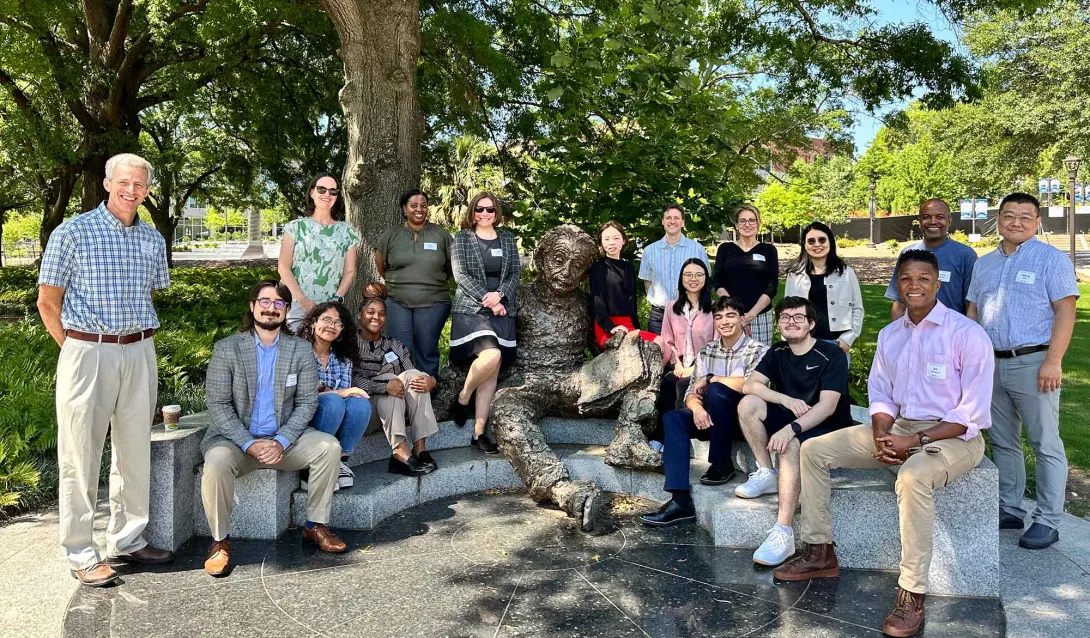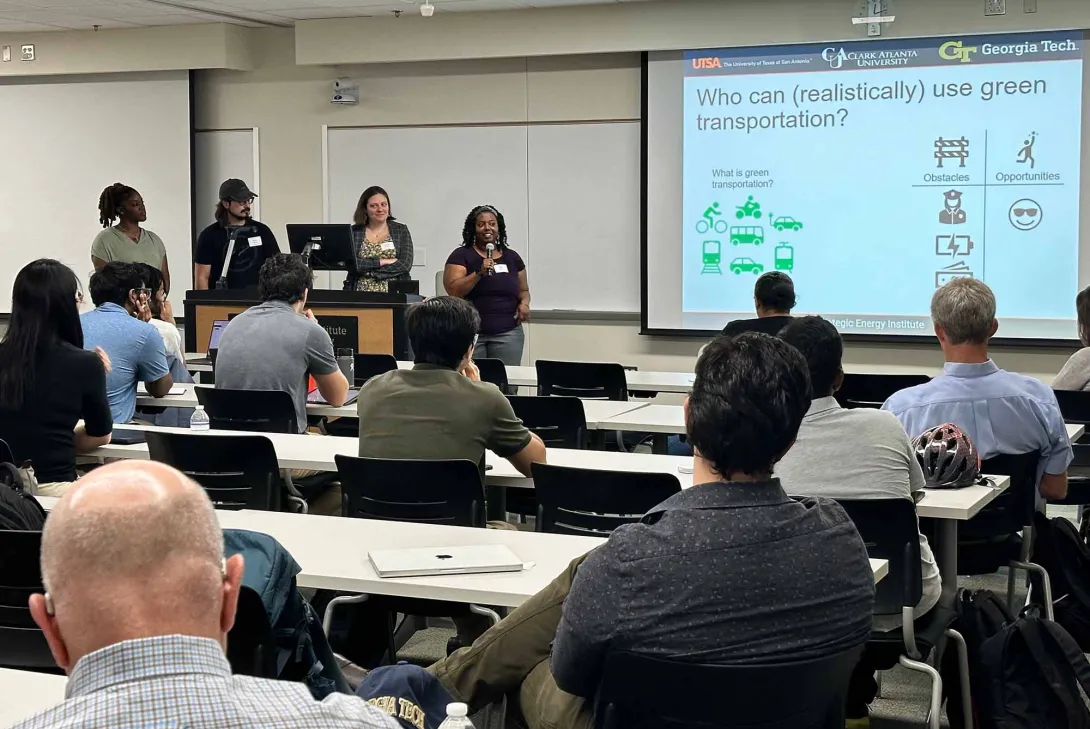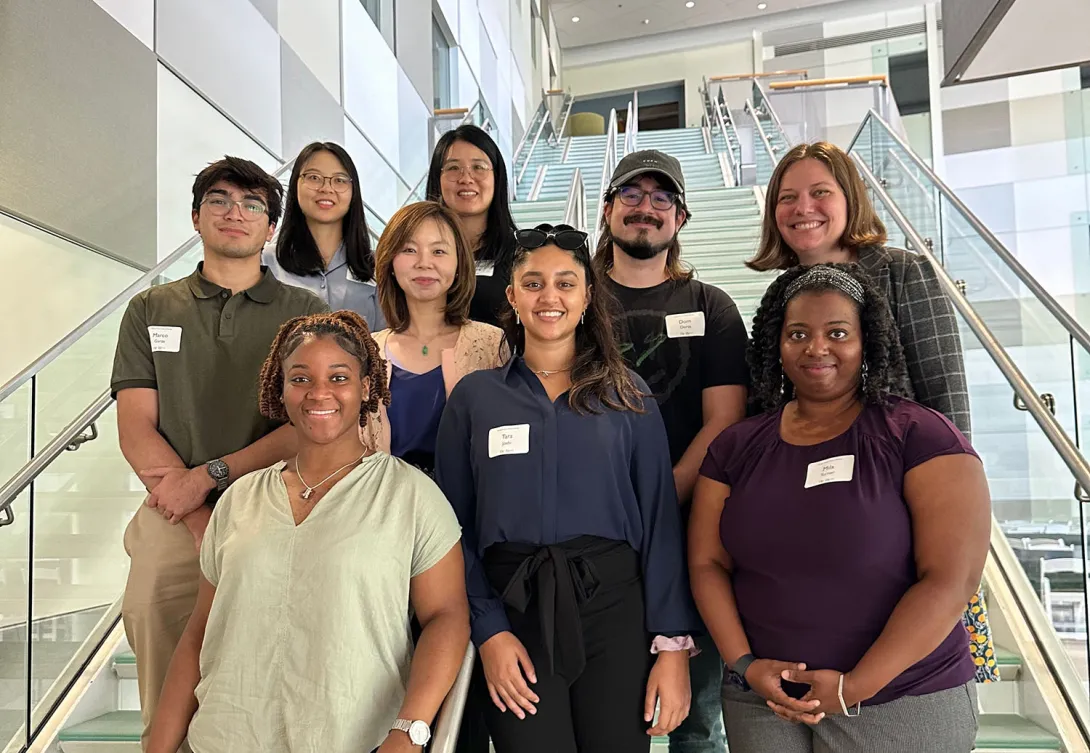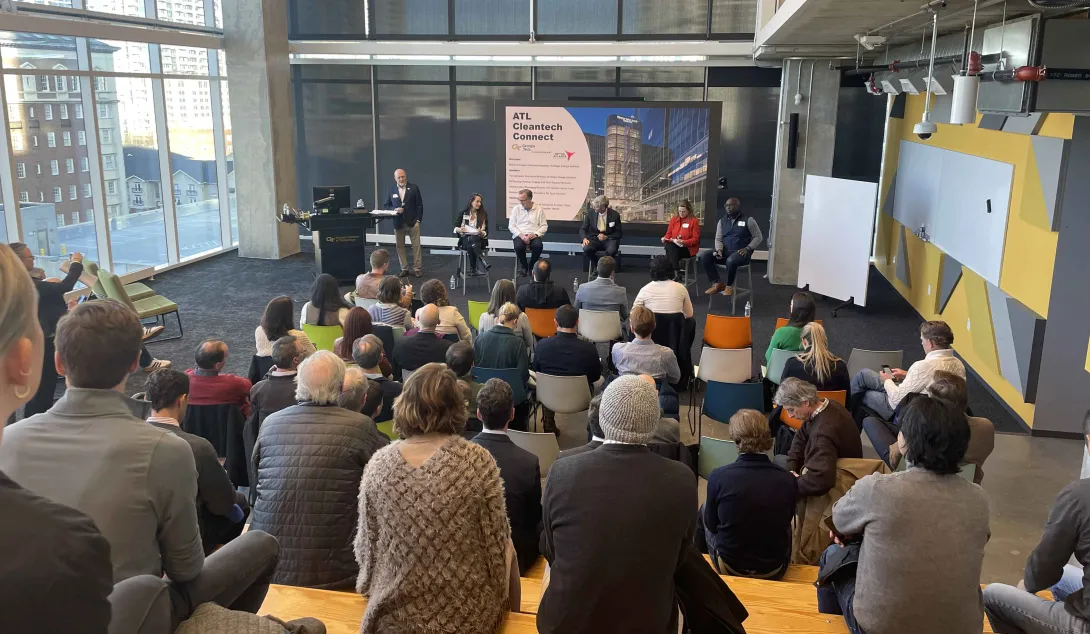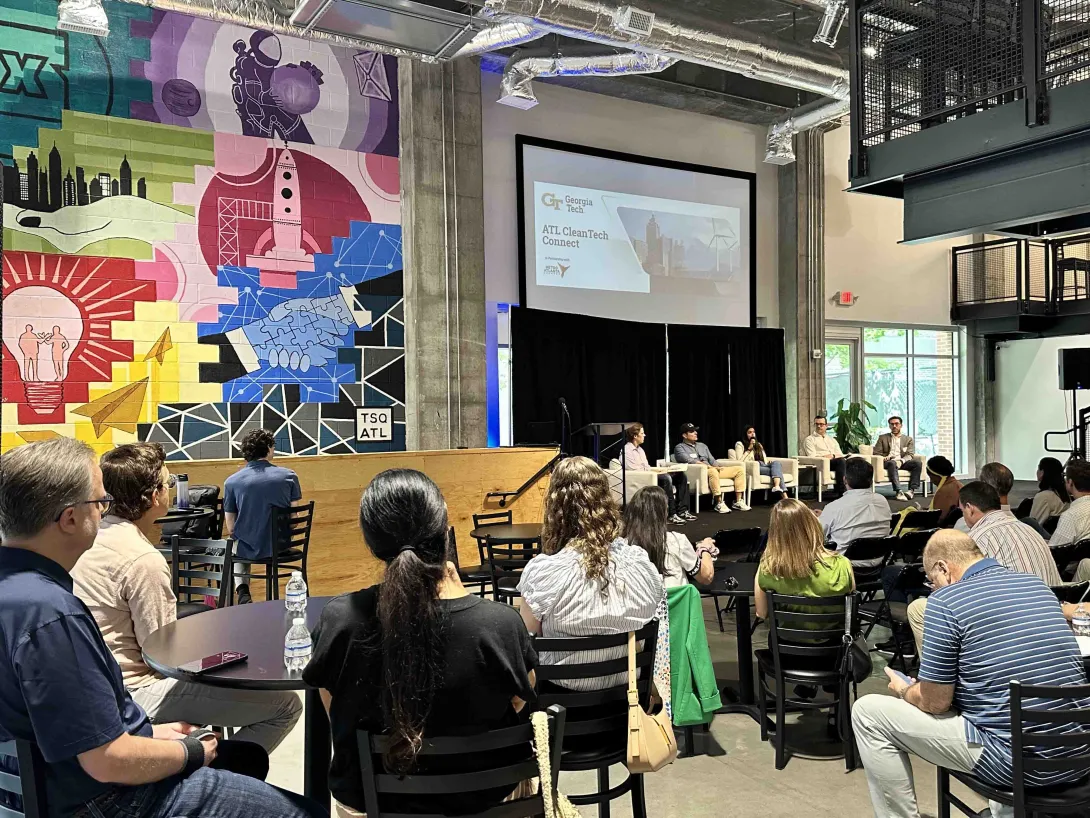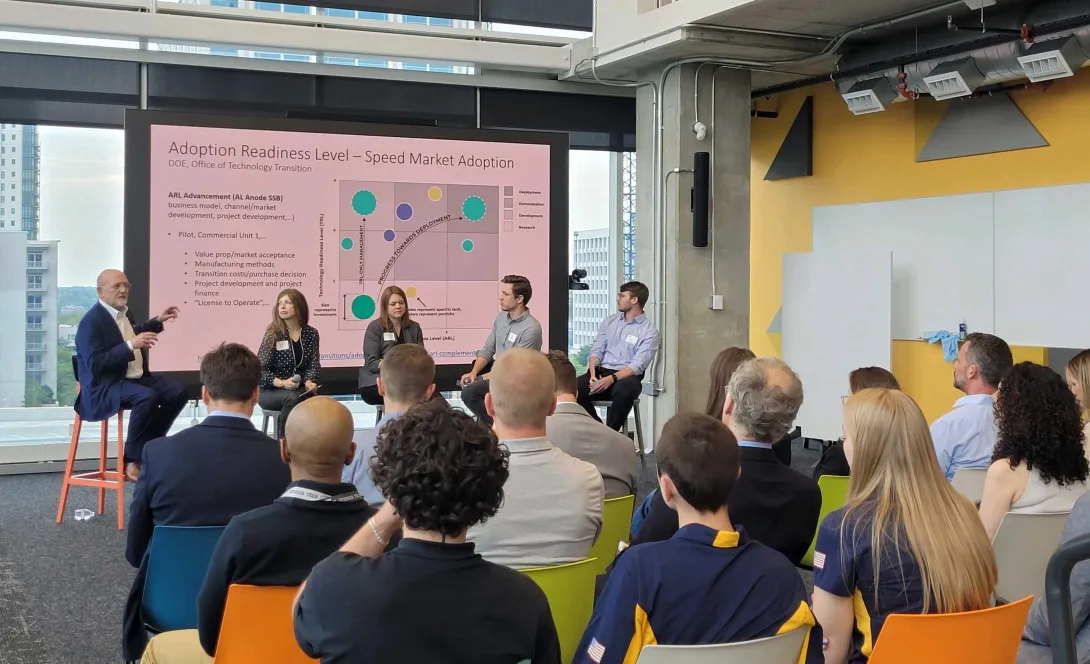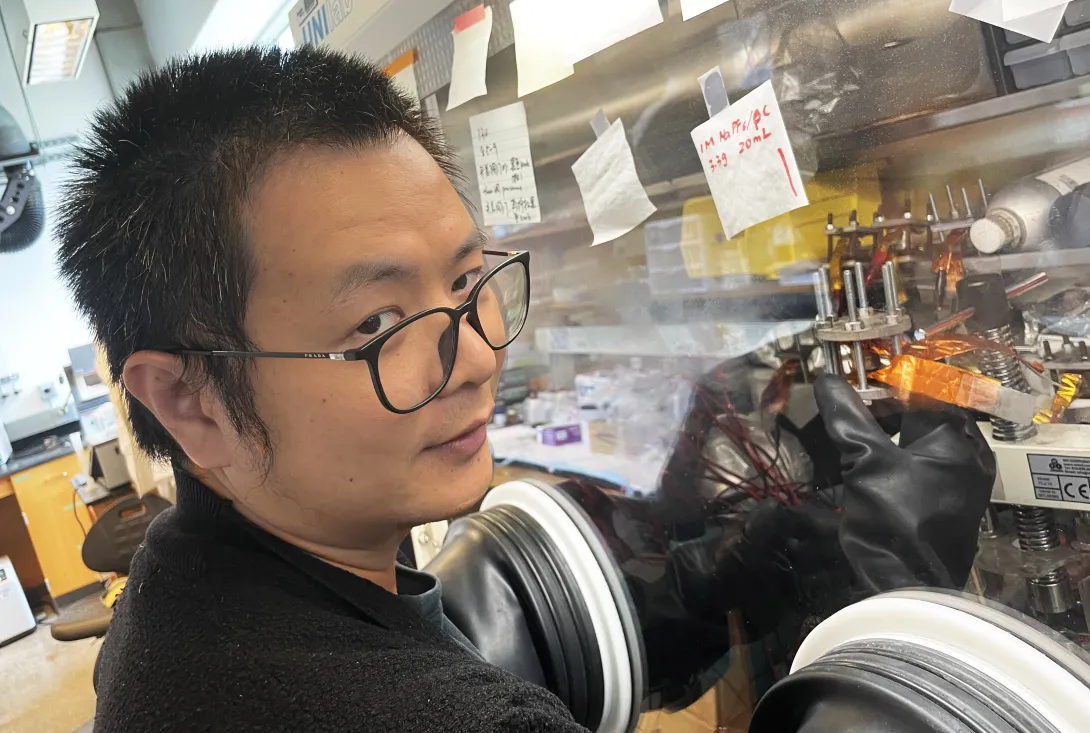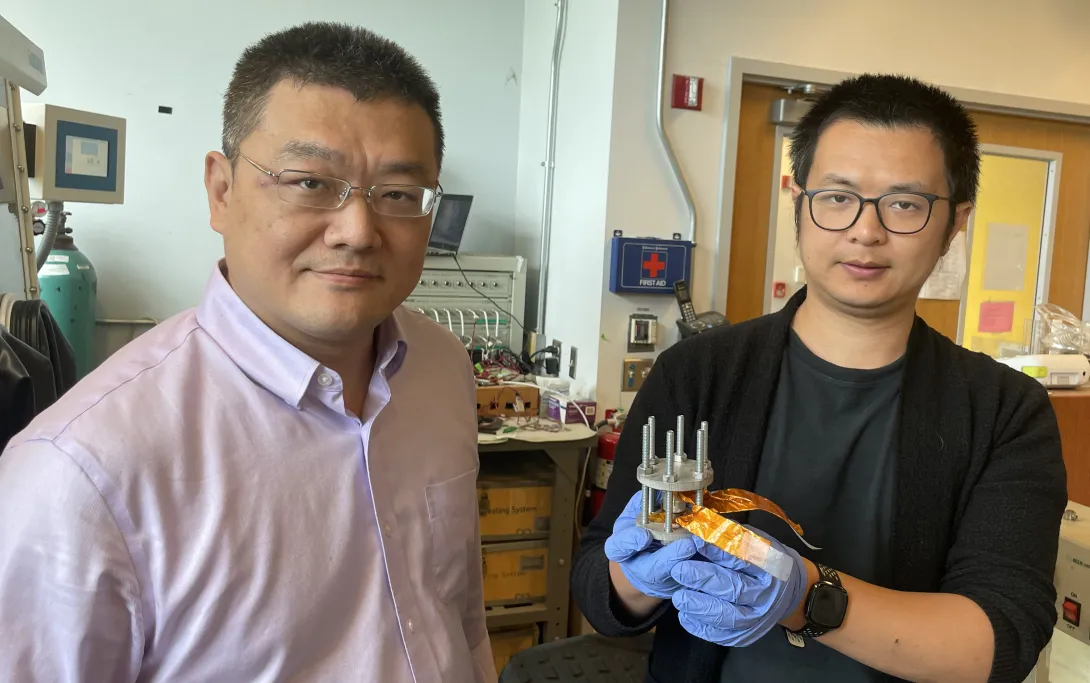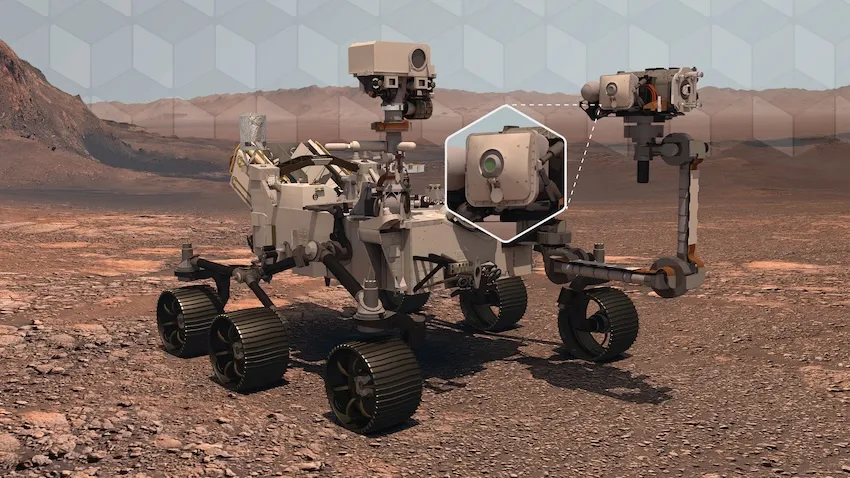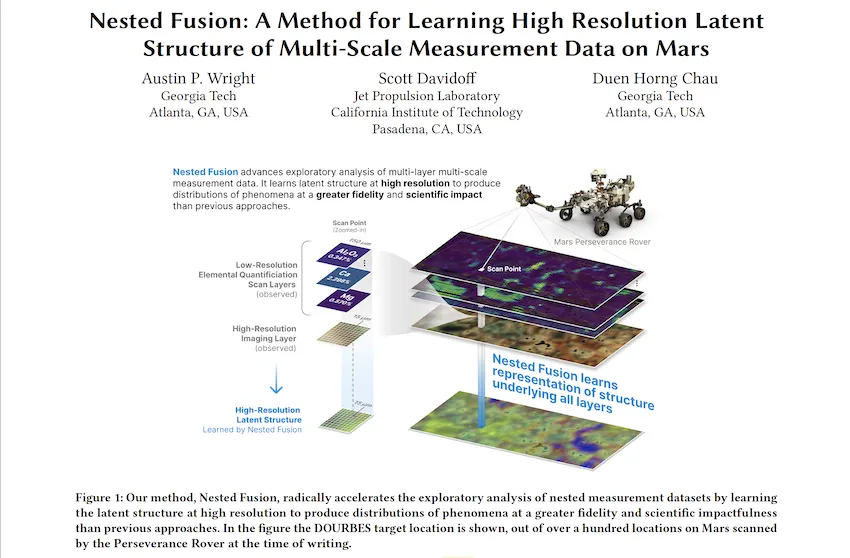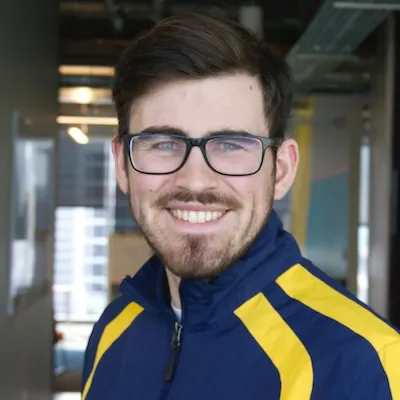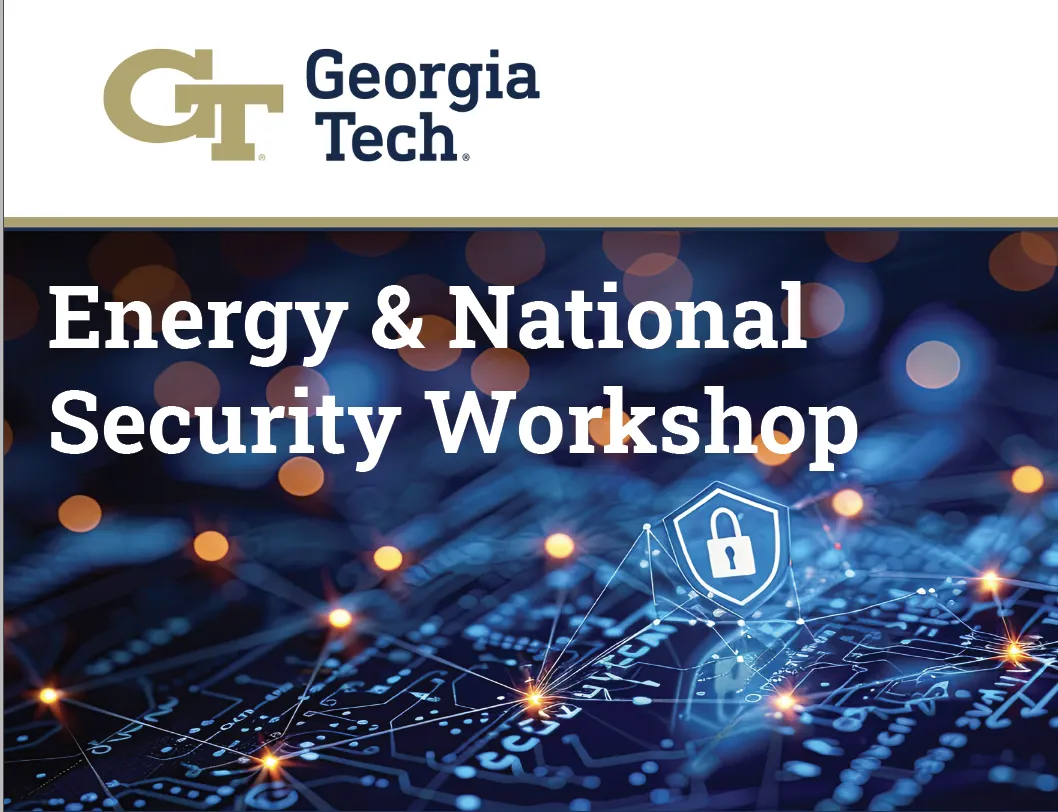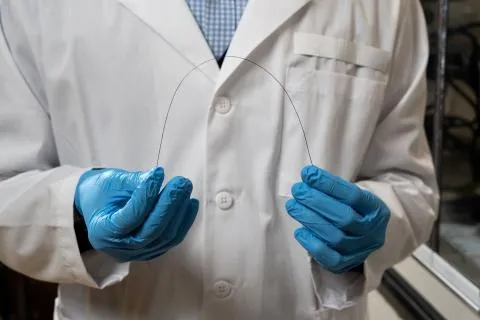Oct. 21, 2024
If you’ve ever watched a large flock of birds on the wing, moving across the sky like a cloud with various shapes and directional changes appearing from seeming chaos, or the maneuvers of an ant colony forming bridges and rafts to escape floods, you’ve been observing what scientists call self-organization. What may not be as obvious is that self-organization occurs throughout the natural world, including bacterial colonies, protein complexes, and hybrid materials. Understanding and predicting self-organization, especially in systems that are out of equilibrium, like living things, is an enduring goal of statistical physics.
This goal is the motivation behind a recently introduced principle of physics called rattling, which posits that systems with sufficiently “messy” dynamics organize into what researchers refer to as low rattling states. Although the principle has proved accurate for systems of robot swarms, it has been too vague to be more broadly tested, and it has been unclear exactly why it works and to what other systems it should apply.
Dana Randall, a professor in the School of Computer Science, and Jacob Calvert, a postdoctoral fellow at the Institute for Data Engineering and Science, have formulated a theory of rattling that answers these fundamental questions. Their paper, “A Local-Global Principle for Nonequilibrium Steady States,” published last week in Proceedings of the National Academy of Sciences, characterizes how rattling is related to the amount of time that a system spends in a state. Their theory further identifies the classes of systems for which rattling explains self-organization.
When we first heard about rattling from physicists, it was very hard to believe it could be true. Our work grew out of a desire to understand it ourselves. We found that the idea at its core is surprisingly simple and holds even more broadly than the physicists guessed.
Dana Randall Professor, School of Computer Science & Adjunct Professor, School of Mathematics
Georgia Institute of Technology
Beyond its basic scientific importance, the work can be put to immediate use to analyze models of phenomena across scientific domains. Additionally, experimentalists seeking organization within a nonequilibrium system may be able to induce low rattling states to achieve their desired goal. The duo thinks the work will be valuable in designing microparticles, robotic swarms, and new materials. It may also provide new ways to analyze and predict collective behaviors in biological systems at the micro and nanoscale.
The preceding material is based on work supported by the Army Research Office under award ARO MURI Award W911NF-19-1-0233 and by the National Science Foundation under grant CCF-2106687. Any opinions, findings, and conclusions or recommendations expressed in this material are those of the authors and do not necessarily reflect the views of the sponsoring agencies.
Jacob Calvert and Dana Randall. A local-global principle for nonequilibrium steady states. Proceedings of the National Academy of Sciences, 121(42):e2411731121, 2024.
Oct. 01, 2024
Whether it’s developing new products, reducing costs, or increasing accessibility, innovations in manufacturing stand to improve the lives of companies and consumers alike. Georgia Tech recently took another step toward ensuring those innovations make it from lab to market with the launch of a Modular Pilot Scale Roll-to-Roll Manufacturing Facility.
“As researchers develop new materials, one of the key aspects we’re missing is how to make them at scale. This is a major oversight because if we can’t make them at scale, we can’t transition from basic research to commercialization,” said Tequila Harris, a professor in the George W. Woodruff School of Mechanical Engineering. “With this new facility, we can prove our discoveries beyond lab-scale studies — and can go from materials innovation to product development at scale.”
Led by Harris, the new facility is the result of a partnership between the Georgia Tech Manufacturing Institute(GTMI), the Strategic Energy Institute, and the Woodruff School. As a pilot facility, it will serve as a testbed for scaling up manufacturing research open for Georgia Tech researchers as well as academic, government, and industry partners around the world.
“The larger vision I see at Georgia Tech involves innovation in manufacturing for large-scale industries,” said Georgia Tech’s Interim Executive Vice President for Research Tim Lieuwen at the facility’s unveiling event on Sept. 19. “It’s crucial that we’re innovating in basic science and technology, but we also need to be innovating in large-scale manufacturing.”
Roll-to-roll (R2R) manufacturing transforms flexible rolls of substrate materials, such as paper, metal foils, and plastics, into more complex, transportable rolls upon coating the surface with one or more fluids, such as inks, suspensions, and solutions, which are subsequently dried or cured on the base substrate. Its high yield and efficiency make R2R an ideal method for the sustainable, large-scale production of components for solar cells, batteries, flexible electronics, and separations — all industries that have expanded in Georgia in recent years.
“As a state institution, we’re ultimately here to serve our state,” said Lieuwen, who is also Regents’ Professor and David S. Lewis Jr. Chair in the Daniel Guggenheim School of Aerospace Engineering. “We’re seeing Georgia emerge as the national leader in terms of recruiting corporate investments in this space and in industries that will be served by this facility.”
Roll-to-Roll Innovations
The R2R process is similar to the production of newspapers, where a large roll of blank paper goes through a series of rollers printing text and photos. “The roll-to-roll aspect is the process of using a specialized tool to force fluid onto a moving surface,” says Harris. It’s one of the fastest-growing methods for producing thin film materials — photovoltaics used in solar cells, transistors in flexible electronics, and micro-batteries, for example — at a large scale.
Harris’s group works to develop novel manufacturing tools, with a particular focus on understanding and improving the dynamics of thin film manufacturing to increase efficiency and minimize waste. Her group is particularly interested in slot die coating, an R2R technique where a liquid material is precisely deposited onto a substrate through a narrow slot. With the new pilot facility, researchers like Harris will be able to take their work to the next level.
“Slot die coating on a roll-to-roll can handle the broadest viscosity range of most coating methods. Therefore, you can process a lot of different materials very quickly and easily,” says Harris. “It’s one of the fastest-growing technologies in the U.S. — and currently, this is the most advanced modular pilot scale facility at an academic university in the United States.”
“Georgia Tech is way ahead of the curve in terms of our facilities,” says GTMI Executive Director and Regents’ Professor Thomas Kurfess. “This will grow our capability in the battery area, membranes, flexible electronics, and more to allow us to support the development of new technologies.”
“As technologies around cleantech continue to advance at an unprecedented pace, pilot manufacturing facilities provide a critical bridge between innovative benchtop research and commercial-scale production and manufacturing,” says Christine Conwell, interim executive director of the Strategic Energy Institute. “We are excited about the opportunities this R2R facility will provide to the Georgia Tech energy community and our industry partners.”
News Contact
Audra Davidson
Research Communications Program Manager
Georgia Tech Manufacturing Institute
Sep. 25, 2024
On Friday, May 10th, four Georgia Tech research teams, supported through the Energy, Policy, and Innovation Center ’s seed grant program presented their research findings to an engaged audience of fellow researchers and students.
The research teams included Georgia Tech faculty from across three colleges who presented their interdisciplinary research findings at the intersection of human health and energy systems.
The event began with a welcome address by Laura Taylor, the interim director of EPIcenter followed by EPIcenter’s director of Research Studies, Rich Simmons, who provided an overview of the vision behind the seed grant program. The seed grants were a culmination of a June 2020 workshop that invited researchers to proactively identify and mitigate new energy-health intersections and challenges by developing the knowledge to respond effectively to the interrelated challenges of public health and our current, and future energy infrastructure. The symposium included presentations from:
- Pengfei Liu, professor in the School of Earth and Atmospheric Sciences, on climate-induced air quality deterioration and its health risks in the Southeastern United States.
- Dan Molzahn, assistant professor in Electrical and Computer Engineering, and Xin Xie, professor in Civil Engineering on assessing the impacts of electric vehicle adoption and charging on air pollution and health
- Shuichi Takayama, professor in Biomedical Engineering on improving toxicology models that measure the impact of particulate matter on lung functioning to enhance energy and environmental policy-making
- Laura Taylor, on linking transit-related air pollution to health outcomes using the causal inference framework.
News Contact
Priya Devarajan || SEI Communications Program Manager
Sep. 25, 2024
Scheller Business Insights is a dynamic video series that highlights the innovative thought leadership of the esteemed faculty at the Georgia Tech Scheller College of Business. At Scheller, we are committed to exploring ideas that educate and inform others about the profound impact of business on our lives and the world.
In this episode, Beril Toktay, Regents' Professor and faculty director of the Ray C. Anderson Center for Sustainable Business, defines net zero and discusses some ways to alleviate climate change by reducing carbon emissions to the point of net zero emissions.
Globally, most major polluters, such as China, the U.S., India, and the EU, are among over 140 nations with net-zero goals, which encompasses roughly 88 percent of global emissions. Meeting the Paris Agreement's 1.5°C climate threshold requires 45 percent emissions cut by 2030 and net-zero emissions by 2050 (United Nations Climate Action).
Toktay describes ways this can be accomplished in different business sectors. For example, in the energy sectors, this means moving from fossil fuels to renewable technologies, and in the transportation sector, moving to electrification and innovative battery technologies as well as developing the infrastructure to support these initiatives. These efforts help move businesses towards achieving net zero as well as providing cleaner air and water, and better health outcomes to the global population.
Listen as Toktay discusses what net zero means, the importance of getting to net zero, and how businesses can help reduce carbon emissions.
News Contact
Lorrie Burroughs
Sep. 25, 2024
After completing a 10-week, on-campus fellowship, the members of this year’s Summer Energy Faculty Fellows Program gathered to present their research and discuss their future plans for continuing their research at their home campus.
The fellowship program, sponsored by the Strategic Energy Institute, is designed to connect faculty and students from historically Black colleges and universities and minority-serving institutions with energy research faculty at Georgia Tech and give them an immersive learning experience tailored to their specific interests. The fellows were competitively selected from a nationwide pool of applicants, and this year, the cohort expanded to include 10 participants. Each of the Fellows brought a student and was hosted by a Georgia Tech energy researcher.
The 2024 Faculty Fellows and their students included:
- Kristen Brown and Dom Forza also of the University of Texas at San Antonio (Host: Joe Bozeman III).
- Guenevere Qian Chen with Marco Garza of the University of Texas at San Antonio (Host: Saman Zonouz).
- Beibei Jiang with Tara Joshi of Kennesaw State University (Host: Hailong Chen).
- Milanika S. Turner with Janiyah White of Clark Atlanta University (Host: Joe Bozeman III).
In addition, the cohort also included a collaborator, Zufen Wang from Tennessee State University, with Veronica Kamel (Host: Comas Haynes).
Below is a Q&A about their experiences at Georgia Tech.
Kristen Brown, Assistant Professor, Civil and Environmental Engineering, and Construction Management
How was your overall experience at Georgia Tech?
I had a wonderful time. The team was welcoming, and the facilities were incredibly nice. Atlanta was an enjoyable city to spend time in with tons of great restaurants, and most of the summer wasn't as hot and humid as I had feared.
What would you like to share about your collaborations with Professor Joe Bozeman, Mila Turner, and the team during the past 10 weeks?
It was great to throw around research ideas with the faculty and I enjoyed chatting with the students at Georgia Tech. The students we brought enjoyed Georgia Tech and achieved so much in a short time. The professors who worked together had similar interests and goals for research, which made discussions engaging, and project selection easy.
What are your key takeaways from this program and any work products that you’d like to elaborate on?
The biggest takeaways aren't necessarily surprising — if you focus on something, you can get a lot done in a short amount of time, but you need to start moving quickly and have lots of progress checks.
What would you like to tell your fellow faculty about this program, and will you encourage them to pursue this opportunity?
I would recommend the program to any faculty considering applying. It is an excellent way to make connections and spur new ideas. It also forces you to act on research ideas, rather than having a great discussion and then lacking progress as other projects take priority.
Guenevere (Qian) Chen, Associate Professor, Cloud Technology Endowed Fellow, Electrical and Computer Engineering
How was your overall experience at Georgia Tech?
My experience at Georgia Tech was truly exceptional! The research environment, the amazing people (host and leaders), and the abundant opportunities made it an incredibly rewarding time.
What would you like to share about your collaborations with Professor Saman Zonouz and the student team during the 10 weeks you were in Atlanta?
It was an exceptional experience. Professor Zonouz is one of the most renowned and successful SCADA/PLC researchers both nationally and internationally. I had the privilege of joining their group meetings, and I was thoroughly impressed by the students' motivation, talent, and productivity. The lab consistently produces high-quality publications and fosters a collaborative and welcoming environment. Zonouz’s leadership and mentorship are outstanding, guiding a team of creative, hard-working, and remarkable students. It was an inspiring and enriching experience to work with such an amazing team.
What are your key takeaways from this program and any work products that you’d like to elaborate on?
My key takeaways from this program include the importance of collaboration, innovation, and the impact of strong mentorship. Working alongside such a talented team has reinforced the value of diverse perspectives and the power of collective effort in driving research forward. The hands-on experience with SCADA and 3D printer security has deepened my technical expertise and broadened my understanding of the challenges and opportunities in this field.
In terms of work products, my student Marco Garza, an incoming sophomore, co-authored a paper with Zonouz’s team, which has been submitted to NDSS-25. Furthermore, Zonouz and I are working on proposals for future collaborative projects.
What would you like to tell your fellow faculty at UTSA about this program and will you encourage them to pursue this opportunity?
I highly recommend this program. Midtown Atlanta is a beautiful place with its own unique charm, and the afternoon rains offer a refreshing break — perfect if you're looking to escape the Texas heat. Beyond the pleasant weather, Georgia Tech provides an outstanding research environment where you can engage in cutting-edge work and collaborate with some of the brightest minds in the field. If you're seeking a personally and professionally rewarding experience, this opportunity at Georgia Tech is one you shouldn’t miss!
Beibei Jiang, Assistant Professor of Innovative Materials, Department of Electrical and Computer Engineering
How was your overall experience at Georgia Tech?
Fantastic. I am impressed by the leadership roles of the program team. They have hosted lots of events, including regular faculty meetings, weekly professional training opportunities for undergraduate students, end-of-program presentation opportunities, and more.
What would you like to share about your collaborations with Professor Hailong Chen and the student team during the 10 weeks you were in Atlanta?
The collaboration with Chen’s team was eye-opening and inspiring. We learned a lot of positive lessons through working with his team. One specific lesson is the research team’s management skills, which involve managing research projects and team members, including undergraduate, graduate, and postdoc students. We also learned a lot of practical experimental skills related to battery fabrication and battery testing. We want to establish a long-term collaboration with Chen’s team in the future.
What are your key takeaways from this program and any work products that you’d like to elaborate on?
The key takeaways from the program can be summarized into three aspects:
- We can propose multiple research ideas based on the interdisciplinary techniques between our team and our collaborators’ team at Georgia Tech
- Considering the close geographic distance between KSU and Georgia Tech, many research opportunities at Georgia Tech can be leveraged by KSU students, including research internships at GTRI and graduate programs at Georgia Tech.
- KSU and Georgia Tech can team up on a lot of educational proposals for workforce development by combining the benefits of the two universities.
Is there any other personal information or experience or any feedback that you’d like to share?
As a Georgia Tech alumnus, I am very proud to see the achievements that Georgia Tech has made in the energy field.
What would you like to tell your fellow faculty at KSU about this program and will you encourage them to pursue this opportunity?
Definitely! I am excited to share all the positive feedback about this collaboration experience with my fellow faculty at KSU. I will tell them about the support and professional development opportunities we received from the SEI team and the program. I will also share my experience working with my collaborator at Georgia Tech, including how the project proceeded efficiently through frequent discussions with their team. Finally, I would like to share the wonderful training opportunities and professional development opportunities for our undergraduate students.
Milanika Turner, Associate Professor, Sociology and Criminal Justice
How was your overall experience at Georgia Tech?
I had such a positive experience! This was my first time visiting the campus, and I was impressed. I want to return when it’s buzzing with the energy of the academic year. I regret not visiting the Library this summer. Plus the facilities at CODA were modern, smart, and aesthetically pleasing. Everyone from Georgia Tech that I’ve met has been helpful, professional, and excited about our institutions working together.
What would you like to share about your collaborations with Professor Joe Bozeman, Professor Kristen Brown, and the student team during the past 10 weeks?
This was the smoothest interdisciplinary collaboration I’ve ever engaged in, because we all started from the common point of centering ethics and justice in our work. We all had a lot of fun thinking together and ideated numerous possible projects.
What are your key takeaways from this program and any work products that you’d like to elaborate on?
A key takeaway is that there is still so much work to be done in the pursuit of clean energy, environmental justice, and sustainable climate solutions. We have a lot more good work to do together.
Is there any other personal information or experience or any feedback that you’d like to share?
My program highlight was witnessing the undergraduate students learn and grow into budding researchers. They truly made me proud.
What would you like to tell your fellow faculty at Clark Atlanta about this program and will you encourage them to pursue this opportunity?
I’d tell my fellow faculty that we should get to know our neighbors! Tech is only two miles from CAU so we could easily get together. Plus we’re already working in some of the same local communities. It would be silly for us not to engage more deeply across universities. It’s beneficial for all of us — especially our students — to work together.
Zufen Wang, Assistant Professor, Civil and Architectural Engineering
How was your overall experience at Georgia Tech?
The overall experience was both inspiring and enriching! It was fantastic to connect with numerous outstanding researchers and learn about their remarkable initiatives and intriguing projects.
What would you like to share about your collaborations with Professor Comas Haynes and the student team during the 10 weeks you were in Atlanta?
Professor Haynes has been incredibly supportive throughout our collaboration. He helped connect me with the researchers for current projects and potential collaborations in the future. Additionally, my student conducted research within Comas' team, and I was impressed by the quality of the student's presentation. The most exciting thing is the IAC program that Comas introduced to me. Together with him and my student, we formed a team with a “train the trainer” approach to learn the IAC process!
What are your key takeaways from this program and any work products that you’d like to elaborate on?
Expand research horizons and valuable connections for interdisciplinary collaborations.
Is there any other personal information or experience or any feedback that you’d like to share?
The team at Georgia Tech is exceptionally welcoming and supportive. They generously share their research and project experiences. Their insights have been incredibly valuable to me, especially as I’m in the early stages of my career.
What would you like to tell your fellow faculty at TSU about this program and will you encourage them to pursue this opportunity?
I will highly encourage them to pursue this opportunity. The program goes beyond just the summer experience. It is a crucial foundation for building strong, long-term collaborations.
Dom Dorsa, Undergraduate Student
Working this summer at Georgia Tech greatly informed my decision to attend the institution for graduate school. My work with Bozeman, Turner, and Brown brought me out of my comfort zone and introduced me to areas of my field (namely GIS) that I was otherwise unfamiliar with. Additionally, I was able to make contacts with SEI and with other researchers such as Matthew Realff, with whom I hope to work someday. My biggest takeaway from this program is that research is a team effort. No one researcher uncovers the world. At best, they identify pieces of a larger puzzle. I hope to come back to Georgia Tech, whether for this program or another, and I am eternally grateful to SEI and to the SURE program for having me.
News Contact
Priya Devarajan || SEI Communications Program Manager
Sep. 24, 2024
Atlanta's Surge in Clean Tech: A Model for National Leadership
When the City of Atlanta adopted the Clean Energy Atlanta resolution in 2019, setting an ambitious goal to achieve 100% clean energy by 2035, few could have predicted the rapid progress the city would make toward becoming a national leader in clean tech innovation. By 2023, the Atlanta clean energy community had coalesced into a powerhouse of innovation, driving the city closer to its clean energy goals.
In January 2024, the launch of the Atlanta CleanTech Connect social marked a pivotal moment in this journey. Co-sponsored by the Metro Atlanta Chamber (MAC) and Georgia Tech’s Strategic Energy Institute (SEI), this event has quickly become a must-attend gathering for Atlanta’s clean energy leaders. Drawing participants from the startup and VC ecosystem, industry, government, academia, and the nonprofit sector, the social serves as a hub for those eager to learn about and contribute to Atlanta’s clean energy future.
Past socials have been well-received, selling out weeks in advance. Attendees have requested a monthly rather than quarterly social. The event format encourages in-depth discussion about clean energy topics and cleantech startup avenues and fosters valuable networking opportunities among professionals united by a common goal: achieving a 100% clean energy future enabled by starting and rapidly growing successful cleantech companies in Atlanta.
“Atlanta CleanTech Connect is a direct result of SEI’s strategic priority to facilitate conversations that result in trusted relationships between innovators, proven entrepreneurs, potential customers, and cleantech investors, all of whom are critical to speed Atlanta startups’ time-to-market. The ultimate goal is for Atlanta to be recognized globally as a top cleantech startup hub, which we can only achieve by rapidly building and scaling more exceptional cleantech companies here at home,” said Richard Gruber, SEI’s senior fellow. Along with Cynthia Curry, senior director of Cleantech Ecosystem Expansion with the Metro Atlanta Chamber, Gruber plays an integral role in creating the social — from choosing the topics to assembling the moderators and panels that have made the event a great success.
The topics covered at these socials have been both timely and important. Discussions have ranged from "Financing Cleantech Hardtech Startups" and "Decarbonization of the Built Environment" to “Innovations in Sustainable Aviation,” offering insights that are crucial for the advancement of clean technologies. These events, held quarterly, will continue into 2025, and the next gathering is scheduled for Wednesday, Oct. 16.
Atlanta is rapidly evolving into a national leader in electric vehicles, next-generation batteries, sustainable fuels, and advanced solar technologies. Since 2018, companies have invested over $11.5 billion in these sectors across Georgia, with the greater Atlanta region at the epicenter of this activity. By facilitating opportunities for the region’s cleantech experts to connect, network, and share knowledge, the Atlanta CleanTech Connect socials are helping to forge the relationships that will support the continued growth of Atlanta’s cleantech startups.
Miguel Granier, managing director of the new Cox Cleantech Accelerator, explained the importance of these gatherings. “Before the ATL CleanTech Connect events, there wasn’t a regular platform where I could connect with other leaders and supporters of cleantech innovation in Atlanta. Cleantech spans multiple industries, so many of us don’t cross paths regularly. We need events like these to bring us together, building relationships that strengthen the entire ecosystem.”
Atlanta CleanTech Connect stands out among the city’s clean technology initiatives for its emphasis on relationship-building as a tool for supporting and expanding the cleantech ecosystem. Other major initiatives, such as the Georgia Cleantech Innovation Hub and the Cox Cleantech Accelerator, have focused on helping individual businesses overcome barriers to success. Together, these complementary approaches have cultivated a robust clean energy ecosystem in Atlanta, making it an attractive destination for clean energy startups and capital investment firms.
Written by: Sharon Murphy, Research Associate at the Strategic Energy Institute
News Contact
Priya Devarajan || SEI Communications Program Manager
Sep. 22, 2024
A multi-institutional research team led by Georgia Tech’s Hailong Chen has developed a new, low-cost cathode that could radically improve lithium-ion batteries (LIBs) — potentially transforming the electric vehicle (EV) market and large-scale energy storage systems.
“For a long time, people have been looking for a lower-cost, more sustainable alternative to existing cathode materials. I think we’ve got one,” said Chen, an associate professor with appointments in the George W. Woodruff School of Mechanical Engineering and the School of Materials Science and Engineering.
The revolutionary material, iron chloride (FeCl3), costs a mere 1-2% of typical cathode materials and canstore the same amount of electricity. Cathode materials affect capacity, energy, and efficiency, playing a major role in a battery’s performance, lifespan, and affordability.
“Our cathode can be a game-changer,” said Chen, whose team describes its work in Nature Sustainability. “It would greatly improve the EV market — and the whole lithium-ion battery market.”
First commercialized by Sony in the early 1990s, LIBs sparked an explosion in personal electronics, like smartphones and tablets. The technology eventually advanced to fuel electric vehicles, providing a reliable, rechargeable, high-density energy source. But unlike personal electronics, large-scale energy users like EVs are especially sensitive to the cost of LIBs.
Batteries are currently responsible for about 50% of an EV’s total cost, which makes these clean-energy cars more expensive than their internal combustion, greenhouse-gas-spewing cousins. The Chen team’s invention could change that.
Building a Better Battery
Compared to old-fashioned alkaline and lead-acid batteries, LIBs store more energy in a smaller package and power a device longer between charges. But LIBs contain expensive metals, including semiprecious elements like cobalt and nickel, and they have a high manufacturing cost.
So far, only four types of cathodes have been successfully commercialized for LIBs. Chen’s would be the fifth, and it would represent a big step forward in battery technology: the development of an all-solid-state LIB.
Conventional LIBs use liquid electrolytes to transport lithium ions for storing and releasing energy. They have hard limits on how much energy can be stored, and they can leak and catch fire. But all-solid-state LIBs use solid electrolytes, dramatically boosting a battery’s efficiency and reliability and making it safer and capable of holding more energy. These batteries, still in the development and testing phase, would be a considerable improvement.
As researchers and manufacturers across the planet race to make all-solid-state technology practical, Chen and his collaborators have developed an affordable and sustainable solution. With the FeCl3 cathode, a solid electrolyte, and a lithium metal anode, the cost of their whole battery system is 30-40% of current LIBs.
“This could not only make EVs much cheaper than internal combustion cars, but it provides a new and promising form of large-scale energy storage, enhancing the resilience of the electrical grid,” Chen said. “In addition, our cathode would greatly improve the sustainability and supply chain stability of the EV market.”
Solid Start to New Discovery
Chen’s interest in FeCl3 as a cathode material originated with his lab’s research into solid electrolyte materials. Starting in 2019, his lab tried to make solid-state batteries using chloride-based solid electrolyteswith traditional commercial oxide-based cathodes. It didn’t go well — the cathode and electrolyte materials didn’t get along.
The researchers thought a chloride-based cathode could provide a better pairing with the chloride electrolyte to offer better battery performance.
“We found a candidate (FeCl3) worth trying, as its crystal structure is potentially suitable for storing and transporting Li ions, and fortunately, it functioned as we expected,” said Chen.
Currently, the most popularly used cathodes in EVs are oxides and require a gigantic amount of costly nickel and cobalt, heavy elements that can be toxic and pose an environmental challenge. In contrast, the Chen team’s cathode contains only iron (Fe) and chlorine (Cl)—abundant, affordable, widely used elements found in steel and table salt.
In their initial tests, FeCl3 was found to perform as well as or better than the other, much more expensive cathodes. For example, it has a higher operational voltage than the popularly used cathode LiFePO4 (lithium iron phosphate, or LFP), which is the electrical force a battery provides when connected to a device, similar to water pressure from a garden hose.
This technology may be less than five years from commercial viability in EVs. For now, the team will continue investigating FeCl3 and related materials, according to Chen. The work was led by Chen and postdoc Zhantao Liu (the lead author of the study). Collaborators included researchers from Georgia Tech’s Woodruff School (Ting Zhu) and the School of Earth and Atmospheric Sciences (Yuanzhi Tang), as well as the Oak Ridge National Laboratory (Jue Liu) and the University of Houston (Shuo Chen).
“We want to make the materials as perfect as possible in the lab and understand the underlying functioning mechanisms,” Chen said. “But we are open to opportunities to scale up the technology and push it toward commercial applications.”
CITATION: Zhantao Liu, Jue Liu, Simin Zhao, Sangni Xun, Paul Byaruhanga, Shuo Chen, Yuanzhi Tang, Ting Zhu, Hailong Chen. “Low-cost iron trichloride cathode for all-solid-state lithium-ion batteries.” Nature Sustainability.
FUNDING: National Science Foundation (Grant Nos. 1706723 and 2108688)
News Contact
Sep. 19, 2024
A new algorithm tested on NASA’s Perseverance Rover on Mars may lead to better forecasting of hurricanes, wildfires, and other extreme weather events that impact millions globally.
Georgia Tech Ph.D. student Austin P. Wright is first author of a paper that introduces Nested Fusion. The new algorithm improves scientists’ ability to search for past signs of life on the Martian surface.
In addition to supporting NASA’s Mars 2020 mission, scientists from other fields working with large, overlapping datasets can use Nested Fusion’s methods toward their studies.
Wright presented Nested Fusion at the 2024 International Conference on Knowledge Discovery and Data Mining (KDD 2024) where it was a runner-up for the best paper award. KDD is widely considered the world's most prestigious conference for knowledge discovery and data mining research.
“Nested Fusion is really useful for researchers in many different domains, not just NASA scientists,” said Wright. “The method visualizes complex datasets that can be difficult to get an overall view of during the initial exploratory stages of analysis.”
Nested Fusion combines datasets with different resolutions to produce a single, high-resolution visual distribution. Using this method, NASA scientists can more easily analyze multiple datasets from various sources at the same time. This can lead to faster studies of Mars’ surface composition to find clues of previous life.
The algorithm demonstrates how data science impacts traditional scientific fields like chemistry, biology, and geology.
Even further, Wright is developing Nested Fusion applications to model shifting climate patterns, plant and animal life, and other concepts in the earth sciences. The same method can combine overlapping datasets from satellite imagery, biomarkers, and climate data.
“Users have extended Nested Fusion and similar algorithms toward earth science contexts, which we have received very positive feedback,” said Wright, who studies machine learning (ML) at Georgia Tech.
“Cross-correlational analysis takes a long time to do and is not done in the initial stages of research when patterns appear and form new hypotheses. Nested Fusion enables people to discover these patterns much earlier.”
Wright is the data science and ML lead for PIXLISE, the software that NASA JPL scientists use to study data from the Mars Perseverance Rover.
Perseverance uses its Planetary Instrument for X-ray Lithochemistry (PIXL) to collect data on mineral composition of Mars’ surface. PIXL’s two main tools that accomplish this are its X-ray Fluorescence (XRF) Spectrometer and Multi-Context Camera (MCC).
When PIXL scans a target area, it creates two co-aligned datasets from the components. XRF collects a sample's fine-scale elemental composition. MCC produces images of a sample to gather visual and physical details like size and shape.
A single XRF spectrum corresponds to approximately 100 MCC imaging pixels for every scan point. Each tool’s unique resolution makes mapping between overlapping data layers challenging. However, Wright and his collaborators designed Nested Fusion to overcome this hurdle.
In addition to progressing data science, Nested Fusion improves NASA scientists' workflow. Using the method, a single scientist can form an initial estimate of a sample’s mineral composition in a matter of hours. Before Nested Fusion, the same task required days of collaboration between teams of experts on each different instrument.
“I think one of the biggest lessons I have taken from this work is that it is valuable to always ground my ML and data science problems in actual, concrete use cases of our collaborators,” Wright said.
“I learn from collaborators what parts of data analysis are important to them and the challenges they face. By understanding these issues, we can discover new ways of formalizing and framing problems in data science.”
Wright presented Nested Fusion at KDD 2024, held Aug. 25-29 in Barcelona, Spain. KDD is an official special interest group of the Association for Computing Machinery. The conference is one of the world’s leading forums for knowledge discovery and data mining research.
Nested Fusion won runner-up for the best paper in the applied data science track, which comprised of over 150 papers. Hundreds of other papers were presented at the conference’s research track, workshops, and tutorials.
Wright’s mentors, Scott Davidoff and Polo Chau, co-authored the Nested Fusion paper. Davidoff is a principal research scientist at the NASA Jet Propulsion Laboratory. Chau is a professor at the Georgia Tech School of Computational Science and Engineering (CSE).
“I was extremely happy that this work was recognized with the best paper runner-up award,” Wright said. “This kind of applied work can sometimes be hard to find the right academic home, so finding communities that appreciate this work is very encouraging.”
News Contact
Bryant Wine, Communications Officer
bryant.wine@cc.gatech.edu
Sep. 18, 2024
This Summer, the Strategic Energy Institute and GTRI jointly created the Energy and National Security Initiative through an inaugural workshop on July 16.
The initiative included Phase 1 or Category A grants that allowed researchers up to $10,000 in seed funding to understand the viability of their research concepts. The multidisciplinary proposals that won the Category A grants include:
Project Title: Energy Infrastructure Security and Risk Assessment Through Interactive Wargaming
Primary Investigator(s)
Dimitri Mavris (School of Aerospace Engineering)
Scott Duncan (School of Aerospace Engineering)
Michael Balchanos (School of Aerospace Engineering)
Other Investigators
Adam Stulberg (School of International Affairs)
Jenna Jordan (School of International Affairs)
Margaret Kosal (School of International Affairs)
Project Title: International Workshop on Nuclear Cybersecurity: Strengthening Global Leadership and Collaboration
Primary Investigator(s)
Fan Zhang (Nuclear and Radiological Engineering)
Steve Biegalski (Nuclear and Radiological Engineering)
Valerie Thomas (School of Industrial and Systems Engineering)
Alexander Miranda (Electrial and Computer Engineering)
Other Investigators
Guenevere Chen (Electrial and Computer Engineering) (University of Texas San Antonio)
Project Title: Robust Energy Systems Planning by way of Novel Systems Engineering (RESPoNSE)
Primary Investigator(s): Comas Haynes (GTRI)
Other Investigators
Matt McDowell (School of Mechanical Engineering and School of Materials Science and Engineering)
Project Title: Shielding and Microreactor Arrangement Innovation (Samμrai)
Primary Investigator(s)
John Brittingham (GTRI)
Bojan Petrovic (School of Mechanical Engineering)
Other Investigators
Helen Works (GTRI)
Project Title: The Strategic Mineral Economy: Challenges and Opportunities for Critical Resources
Primary Investigator(s)
Bobby Harris (School of Economics)
Matthew Swarts (GTRI)
Other Investigators
Dylan Brewer (School of Economics)
Kevin Caravati (GTRI)
Laura Taylor (School of Economics)
Micah S. Ziegler (School of Chemical and Biomolecular Engineering, School of Public Policy)
Project Title: Trustworthy AI for Critical Power Grid Infrastructure Resilience
Primary Investigator(s):
Glen Chou (School of Cybersecurity and Privacy)
Yatis Dodia (GTRI)
Saman Zonouz (School of Cybersecurity and Privacy, School of Electrical and Computer Engineering)
Phase 2 or Category B of the initiative includes up to $500,000 in seed funding to fund team research proposals, with funds likely to grow to $1.2 million in the coming years. Please note that teams must largely consist of those who participated in or expressed interest via the July workshop.
Georgia Tech researchers and faculty are encouraged to submit the Notice of Intent for Phase 2 (Category B) submissions. While this is not a requirement of the proposal, it will provide the initiative with insights that will help with internal logistics. If you have any questions regarding the Category B Notice of Intent and the grant, please contact the Strategic Energy Institute at connect@energy.gatech.edu.
News Contact
Priya Devarajan || SEI Communications Program Manager
Sep. 06, 2024
The need to remove organic contaminants from surface waters continues to grow due to an increasing influx from industrial, municipal, and agricultural sources. But these contaminants are challenging to remove outside of thermally driven separation processes, such as distilling or drying, which consume significant amounts of energy.
However, researchers in Georgia Tech’s School of Chemical and Biomolecular Engineering (ChBE) have developed rigid, carbon membranes that effectively remove and concentrate small organic molecules (such as solvents) from water, based on the affinity between the organic species and carbon membrane.
Pagination
- Previous page
- 9 Page 9
- Next page
